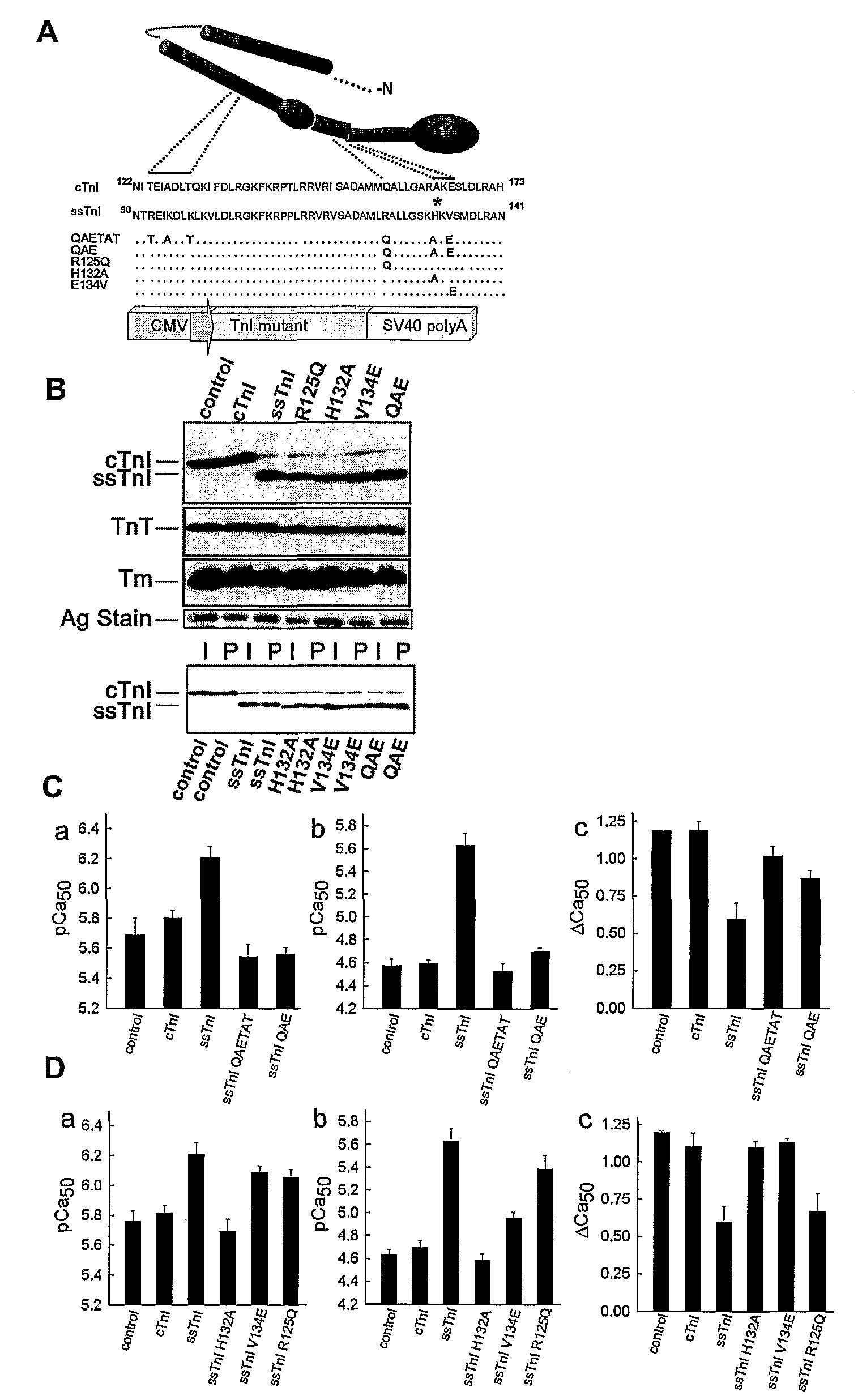Compositions And Methods For Regulating Cardiac Performance
a technology of cardiac performance and composition, applied in the field of regulating cardiac performance, can solve the problems of heart failure, reduced heart pumping ability, heart failure, etc., and achieve the effect of improving physiologic function
- Summary
- Abstract
- Description
- Claims
- Application Information
AI Technical Summary
Benefits of technology
Problems solved by technology
Method used
Image
Examples
example 1
Materials and Methods
[0104]TnI substitutions and viral vector construction: Wild-type cTnI and ssTnI cDNAs and cTnI with a FLAG epitope on the C-terminus (Michele et al., J Cell Biol 145:1483 (1999)) were used to construct the gain of function A164H substitution. A pGEM-3Z vector containing cTnI or ssTnI, and the QuikChange mutagenesis kit (Stratagene) were used to generate substitutions in cTnI and ssTnI. The primers used for mutagenesis of cTnI to cTnIA164H removed an Xma1 site and were 5′-ggcactactggggacccggcacaaggaatccttggacctg-3′ (sense) (SEQ ID NO: 1) and 5′-caggtccaaggattccttgtgccgggtccccagtagtgcc-3′ (antisense) (SEQ ID NO: 2). The mutants constructed from wild-type ssTnI included ssTnIR125Q, ssTnIH132A, ssTnIV134E, and ssTnIR125Q / H132A / V134E (ssTnIQAE; QAETAT). A unique Ava I site was introduced into ssTnIR125Q, ssTnIH132A, and ssTnIV134E, and this site was subsequently removed from ssTnIR125Q to construct the ssTnIQAE mutant. The primers used for mutagenesis to ssTnIR125Q w...
example 2
Characterization of Troponin I (TnI) Residues Conferring pH Sensitivity
[0114]To address whether a limited domain or residue can confer pH sensitivity, a series of ssTnI mutants incorporating 3-6 conserved residue substitutions from cTnI, designated QAETAT and QAE ssTnI mutants, were constructed (See, e.g., FIG. 1). Upon gene transfer to adult cardiac myocytes from rats, the mutant TnIs stoichiometrically replaced >90% of endogenous cTnI, with no other detected changes in sarcomere protein expression (See, e.g., FIG. 1B). These cardiac TnI substitutions into ssTnI to form ssTnIQAE fully converted the ssTnI contractile phenotype to the cTnI phenotype as assessed by single myocyte recordings of isometric tension at varied steady-state levels of calcium activation (See, e.g., FIG. 1C). This narrowed the pH sensitivity domain to 3 amino acids. These amino acids are located in helixes 3 and 4 in TnI, which are predicted to act as an important molecular switch domain that toggles between a...
example 3
Generation of cTnIA164H Transgenic Mice
[0115]Five independent lines of transgenic mice were generated using the α-myosin heavy chain promotor to direct cardiac-restricted expression of the cTnIA164H cDNA (See, e.g., FIG. 2). A C-terminal Flag epitope was used to aid in detection of cTnIA164H. Gene transfer studies showed that the Flag epitope did not alter the calcium or pH sensitivity of isometric force in cardiac myocytes. All transgenic (tg) lines were viable and reproductively fit. Stoichiometric replacement of native cTnI by cTnIA164H varied between 51-83% among the five transgenic lines (See, e.g., FIGS. 2B and 2C). Sarcomeric localization of cTnIA164H was confirmed by confocal projection imaging of indirect immunofluorescently-labeled myocardial sections. Correspondingly, there was a marked gain-of-function in isometric tension recordings in chemically permeabilized myocytes that was particularly dramatic at pH 6.20, and correlated with the extent of TnI replacement (See, e.g...
PUM
| Property | Measurement | Unit |
|---|---|---|
| diameter | aaaaa | aaaaa |
| pH | aaaaa | aaaaa |
| pH | aaaaa | aaaaa |
Abstract
Description
Claims
Application Information
 Login to View More
Login to View More - R&D
- Intellectual Property
- Life Sciences
- Materials
- Tech Scout
- Unparalleled Data Quality
- Higher Quality Content
- 60% Fewer Hallucinations
Browse by: Latest US Patents, China's latest patents, Technical Efficacy Thesaurus, Application Domain, Technology Topic, Popular Technical Reports.
© 2025 PatSnap. All rights reserved.Legal|Privacy policy|Modern Slavery Act Transparency Statement|Sitemap|About US| Contact US: help@patsnap.com



